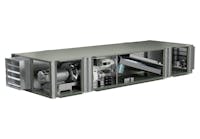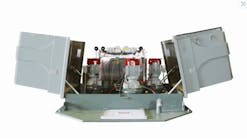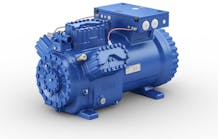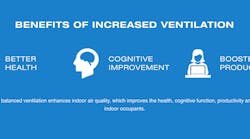Latest from IAQ & Ventilation
New HVACR Products: March 2025
AHR Day 1: HPAC's Products Picks
New HVACR Products: January 2025
New HVACR Products: December 2024
New HVACR Products: September 2024
New HVACR Products: August 2024
S&P USA Names New National Director of Sales
New HVACR Products: July 2024
Modern Parallels to July 1929, with Rob McManamy
By NICK AGOPIAN, RenewAire, Waunakee, WI
There’s a long list of contaminants of concern (CoC) that HVAC engineered designs must ventilate for today, but perhaps CO2 has the most unique ramifications on the human condition.
Recent studies reveal that higher than normal levels of CO2 decrease cognitive functions that lead to productivity issues in office workers. In education settings, excessive CO2 levels lead to lower student test scores. CO2 levels have steadily increased indoors the last three decades as construction codes mandated tighter building envelopes in the quest for better energy efficiency. Therefore, today’s tighter building construction methods are partially responsible for this alarming rise CO2. The solution is adding energy-efficient outdoor air technology to dilute indoor airborne CoC, including, but not limited to CO2, so it has minimal effect on the human condition.
There are plenty of past HVAC engineering designs that have had a devastating impact on the human condition. A great example is indoor pool chloramines, which are formed when indoor pool water-based chlorine atoms combine with atoms of human body byproducts, such as ammonia and urine, to sanitize them. The result is a heavy, toxic gas that stratifies above the pool water surface in the swimmer’s breathing zone. Indoor pool construction’s heyday of the 1980’s and 1990’s produced hundreds of facilities with what might have been perceived as cutting-edge ventilation design at the time. Decades later however, Lifeguard Lung (granulomatous pneumonitis), a damaging respiratory ailment caused by excessive amounts of chloramines has gained international attention recently. It has made swimmers sick at poolside and disrupted swim meets ranging from high school level competition to U.S. Olympic time trials.
Another example of engineering design that proved harmful to the human condition is the use of asbestos insulation for boiler piping throughout the first half of the 20th Century. Asbestos insulation was the state-of-the-art at the time, but little did engineers know then that someday asbestos would be related to respiratory conditions such as mesothelioma.
Studies are just now finding that CO2 might be the most critical CoC in tightly-constructed buildings. As more research is completed and engineers someday look back at this current period of HVAC engineering design, CO2 might be considered equally as harmful to the human condition as chloramines or asbestos.
Studies Prove Negative Effects of CO2
The CO2 study that stands out is Associations of Cognitive Function Scores with Carbon Dioxide, Ventilation, and Volatile Organic Compound Exposures in Office Workers: A Controlled Exposure Study of Green and Conventional Office Environments developed by the Harvard T.H. Chan School of Public Health, Boston, in its Department of Environmental Health’s Exposure, Epidemiology and Risk Program.
The 2015 study posed participants in a conventional building test environment versus a “green” environment with few variables other than controlled CO2 concentrations. Nine different functional domains were assessed:
- Basic Activity Level;
- Applied Activity Level;
- Focused Activity Level;
- Task Orientation;
- Crisis Response;
- Information Seeking;
- Information Usage;
- Breadth of Approach; and
- Strategy.
The three domains that stood out in the study were Crisis Response, Strategy and Information Usage (97, 172, 131-percent higher in green v. conventional test environments, respectively), which are related to higher cognitive function and decision making.
The green environment produced cognitive scores that were 61-percent and 101-percent higher on day 1 and day 2, respectively, versus conventional environments created by the study where CO2 levels were 600 to 1,000 and 2,500-ppm.
Another study, Is CO2 an Indoor Pollutant? Direct Effects of Low-to-Moderate CO2 Concentrations on Human Decision-Making Performance by the Lawrence Berkeley National Laboratory (LBNL) in 2012 confirmed many of the Harvard study’s cognitive function findings. The LBNL and Harvard studies used human cognitive test criteria developed by Dr. Usha Satish in the Upstate Medical University department of the State University of New York (SUNY).
Aside from cognitive function, high CO2 levels have also been correlated with lower test scores in schools.
Furthermore, NASA is also concerned with CO2 in the International Space Station (ISS) and is expected to find methods to reduce the levels in the near future.
There is enough study evidence for engineers and contractors to educate building owners on CO2 effects and specify equipment that minimizes airborne contaminants. However, ideal indoor CO2 levels should are still open for debate. Outdoor CO2 levels have steadily risen to just over 400-ppm due to climate change. Indoor levels can run anywhere from 600 to 3,000-ppm, the latter which is commonly found in high occupant density areas, such as crowded classrooms. Ironically, the National Institute for Occupational Safety and Health (NIOSH) calls for 1,000-ppm or less of CO2., which surpasses cognitive level safe zones revealed by most studies. Most study facilitators saw a noticeable change in cognitive function where the test spaces’ CO2 were purposely raised 400-ppm or more above their base levels. Since outdoor CO2 levels average slightly more than 400-ppm, they can be used to lower average indoor CO2 levels by incorporating more outdoor air via ventilation.
How To Minimize CO2
Oversizing new RTUs or calibrating existing units to surpass the current ASHRAE Standard 62.1 recommendations for outdoor air is one solution, but that strategy carries a significant energy penalty for dehumidifying, heating or cooling the additional air. The oversized new equipment’s additional energy usage may also fall short of ASHRAE Standard 90.1 compliancy for energy efficiency. Thus the engineer must walk a tightrope of providing additional outdoor air for IAQ, but also complying with energy efficiency requirements, which eventually will be future law under the U.S. Department of Energy (DOE) requirements.
The answer is energy recovery ventilators (ERV) or dedicated outdoor air dehumidifiers (DOAS) equipment for outdoor air consideration in new construction and retrofit projects. Specifying ERV or DOAS is beneficial in new construction, but also in retrofit situations, because odds are high that the original space may change in terms of occupant density, occupant use or sensible load throughout its lifecycle. An office space designed for a few desk workers that is later converted to an area generating more heat and respiration, such as a fitness gym with 50 occupants, will certainly need more outdoor air capacity than the original intent.
Specifying ERV or DOAS: That is the Question
DOAS and ERV each have individual benefits for different HVAC formats. For example, DOAS is ideal for VRF/VFV systems, radiant panels and chilled beam applications that have little capacity for latent loads and outdoor air compliances. DOAS can handle the latent load of outdoor air and allow VRF/VRV systems, radiant panels and chilled beams to cool or heat the space. For RTU systems, DOAS can provide outdoor air with optimum relative humidity more energy-efficiently before the RTU conditions it for the space. It can be ducted into the space, combined with indoor air handlers, function independently of other equipment, or just simply provide air into a space without ducting.
While DOAS are typically used in conjunction with some type of HVAC system, they can also function as 100-percent outdoor air units. Ideal 100-percent outdoor air applications are gyms, battery storage rooms, animal hospitals, operating rooms, laboratories and other areas where recirculating indoor air with excessive VOCs, particulates or biological contaminants can harm occupants. Of course, CO2 levels would also decrease to outdoor air levels during the process.
ERV technology, on the other hand, is ideal for applications where exhaust air has thermal attributes that can be extracted to pre-condition outdoor air.
On-demand ventilation can also be part of the solution. Instead of increasing outdoor air at a constant percentage, sensors detect whether CO2 levels have surpassed a predetermined set point and then activate the DOAS system when needed to dilute CO2 independently of the temperature/humidity control. The unit can turn off after acceptable levels are reached, or via occupancy sensors for energy-efficiency during off-peak hours. In most cases, diluting CO2 levels will most likely bring other CoCs down to acceptable levels.
Recent studies prove that minimizing indoor CO2 and maintaining recommended levels will enhance human cognitive function and worker productivity, while also increasing test scores in school environments. Engineers and contractors should use DOAS and ERV in both new construction and retrofit applications to ensure minimum CO2 and CoC levels until it is known what long-term effects these air pollutants have on IAQ and the human condition.
A 37-year veteran of the HVAC industry, Agopian holds an engineering degree from Vanier College and an MBA from Duke University. He is a member of ASHRAE TC 2.3 “Gaseous Air Contaminants and Gas Contaminant Removal Equipment” and ASHRAE SPC 62.1 “Ventilation for Acceptable Indoor Air Quality” committees. Now Vice President of Sales and Marketing at RenewAire, he can be reached at nagopian@renewaire.com.













